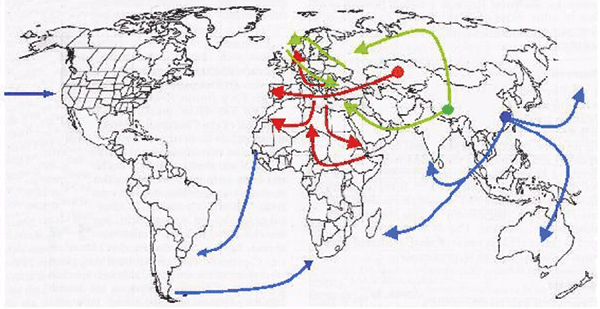Volume 10, Number 9—September 2004
Research
Genotyping, Orientalis-like Yersinia pestis, and Plague Pandemics
Appendix Figure 4

Appendix Figure 4. Geographic origin and routes of spreading of three historical plague pandemics labeled in red (Justinian plague), green (Black Death), and blue (modern), according to historical transcriptions reviewed in Perry (2).
References
- Kortepeter M, Parker G. Potential biological weapons threats. Emerg Infect Dis. 1999;5:523–7. DOIPubMedGoogle Scholar
- Perry RD, Fetherston JD. Yersinia pestis–etiologic agent of plague. Clin Microbiol Rev. 1997;10:35–66.PubMedGoogle Scholar
- Wren BW. The yersiniae—a model genus to study the rapid evolution of bacterial pathogens. Nat Rev Microbiol. 2003;1:55–64. DOIPubMedGoogle Scholar
- Parkhill J, Wren BW, Thomson NR, Titball RW, Holden MT, Prentice MB, Genome sequence of Yersinia pestis, the causative agent of plague. Nature. 2001;413:523–7. DOIPubMedGoogle Scholar
- Deng W, Burland V, Plunkett G III, Boutin A, Mayhew GF, Liss P, Genome sequence of Yersinia pestis KIM. J Bacteriol. 2002;184:4601–11. DOIPubMedGoogle Scholar
- Andersson SG, Zomorodipour A, Andersson JO, Sicheritz-Ponten T, Alsmark UC, Podowski RM, The genome sequence of Rickettsia prowazekii and the origin of mitochondria. Nature. 1998;396:133–40. DOIPubMedGoogle Scholar
- Ogata H, Audic S, Renesto-Audiffren P, Fournier PE, Barbe V, Samson D, Mechanisms of evolution in Rickettsia conorii and R. prowazekii. Science. 2001;293:2093–8. DOIPubMedGoogle Scholar
- Achtman M, Zurth K, Morelli G, Torrea G, Guiyoule A, Carniel E. Yersinia pestis, the cause of plague, is a recently emerged clone of Yersinia pseudotuberculosis. Proc Natl Acad Sci U S A. 1999;96:14043–8. DOIPubMedGoogle Scholar
- Guiyoule A, Grimont F, Iteman I, Grimont PA, Lefevre M, Carniel E. Plague pandemics investigated by ribotyping of Yersinia pestis strains. J Clin Microbiol. 1994;32:634–41.PubMedGoogle Scholar
- Mollet C, Drancourt M, Raoult D. rpoB sequence analysis as a novel basis for bacterial identification. Mol Microbiol. 1997;26:1005–11. DOIPubMedGoogle Scholar
- Kanehisa M, Goto S, Kawashima S, Nakaya A. The KEGG databases at GenomeNet. Nucleic Acids Res. 2002;30:42–6. DOIPubMedGoogle Scholar
- Rozen S, Skalestky HJ. Totowa (NJ): Humana Press; 2000. p. 365–86.
- Altschul SF, Madden TL, Schaffer AA, Zhang J, Zhang Z, Miller W, Gapped BLAST and PSI-BLAST: a new generation of protein database search programs. Nucleic Acids Res. 1997;25:3389–402. DOIPubMedGoogle Scholar
- Kumar S, Tamura K, Jakobsen IB, Nei M. MEGA 2: molecular evolutionary genetics analysis software, 2001. Tempe (AZ): Arizona State University; 2001.
- Felsenstein J. PHYLIP–Phylogeny Inference Package (version 3.2). Cladistics. 1989;5:164–6.
- Castex D, Friess M. In: Kemkes-Grottenthaler A, Henke W, editors. Pein und Plagen. Aspekte einer Historischen Epidemiologie. Francfort: Archaea, Epidemiologie; 1998.
- Cabezuelo U, Castex D. Dolmens, sarcophages et pierres tombales. Chartres: Maison de l'Archéologie;1994. p. 68–70.
- Raoult D, Aboudharam G, Crubezy E, Larrouy G, Ludes B, Drancourt M. Molecular indentification by "suicide PCR" of Yersinia pestis as the agent of medieval Black Death. Proc Natl Acad Sci U S A. 2000;97:12800–3. DOIPubMedGoogle Scholar
- Drancourt M, Aboudharam G, Signoli M, Dutour O, Raoult D. Detection of 400-year-old Yersinia pestis DNA in human dental pulp: an approach to the diagnosis of ancient septicemia. Proc Natl Acad Sci U S A. 1998;95:12637–40. DOIPubMedGoogle Scholar
- Golenberg EM. Ancient DNA. New York: Springer-Velag; 1994. p. 237–56.
- Guiyoule A, Rasoamanana B, Buchrieser C, Michel P, Chanteau S, Carniel E. Recent emergence of new variants of Yersinia pestis in Madagascar. J Clin Microbiol. 1997;35:2826–33.PubMedGoogle Scholar
- Lucier TS, Brubaker RR. Determination of genome size, macrorestriction pattern polymorphism, and nonpigmentation-specific deletion in Yersinia pestis by pulsed-field gel electrophoresis. J Bacteriol. 1992;174:2078–86.PubMedGoogle Scholar
- Portnoy DA, Falkow S. Virulence-associated plasmids from Yersinia enterocolitica and Yersinia pestis. J Bacteriol. 1981;148:877–83.PubMedGoogle Scholar
- Protsenko OA, Filippov AA, Kutyrev VV. Integration of the plasmid encoding the synthesis of capsular antigen and murine toxin into Yersinia pestis chromosome. Microb Pathog. 1991;11:123–8. DOIPubMedGoogle Scholar
- Filippov AA, Oleinikov PV, Motin VL, Protsenko OA, Smirnov GB. Sequencing of two Yersinia pestis IS elements, IS285 and IS100. Contrib Microbiol Immunol. 1995;13:306–9.PubMedGoogle Scholar
- Simonet M, Riot B, Fortineau N, Berche P. Invasin production by Yersinia pestis is abolished by insertion of an IS200-like element within the inv gene. Infect Immun. 1996;64:375–9.PubMedGoogle Scholar
- Odaert M, Devalckenaere A, Trieu-Cuot P, Simonet M. Molecular characterization of IS1541 insertions in the genome of Yersinia pestis. J Bacteriol. 1998;180:178–81.PubMedGoogle Scholar
- McDonough KA, Hare JM. Homology with a repeated Yersinia pestis DNA sequence IS100 correlates with pesticin sensitivity in Yersinia pseudotuberculosis. J Bacteriol. 1997;179:2081–5.PubMedGoogle Scholar
- Motin VL, Georgescu AM, Elliott JM, Hu P, Worsham PL, Ott LL, Genetic variability of Yersinia pestis isolates as predicted by PCR-based IS100 genotyping and analysis of structural genes encoding glycerol-3-phosphate dehydrogenase (glpD). J Bacteriol. 2002;184:1019–27. DOIPubMedGoogle Scholar
- Klevytska AM, Price LB, Schupp JM, Worsham PL, Wong J, Keim P. Identification and characterization of variable-number tandem repeats in the Yersinia pestis genome. J Clin Microbiol. 2001;39:3179–85. DOIPubMedGoogle Scholar
- Adair DM, Worsham PL, Hill KK, Klevytska AM, Jackson PJ, Friedlander AM, Diversity in a variable-number tandem repeat from Yersinia pestis. J Clin Microbiol. 2000;38:1516–9.PubMedGoogle Scholar
- Gilbert MT, Cuccui J, White W, Lynnerup N, Titball RW, Cooper A, Absence of Yersinia pestis-specific DNA in human teeth from five European excavations of putative plague victims. Microbiology. 2004;150:341–54. DOIPubMedGoogle Scholar
Page created: March 03, 2014
Page updated: March 03, 2014
Page reviewed: March 03, 2014
The conclusions, findings, and opinions expressed by authors contributing to this journal do not necessarily reflect the official position of the U.S. Department of Health and Human Services, the Public Health Service, the Centers for Disease Control and Prevention, or the authors' affiliated institutions. Use of trade names is for identification only and does not imply endorsement by any of the groups named above.